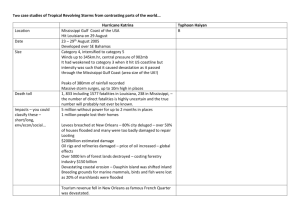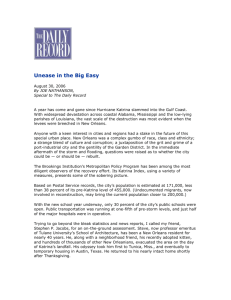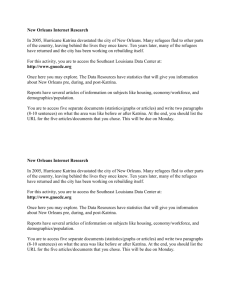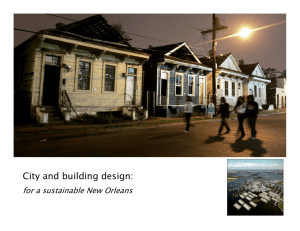1 The Organization of the Paper and Talk
advertisement
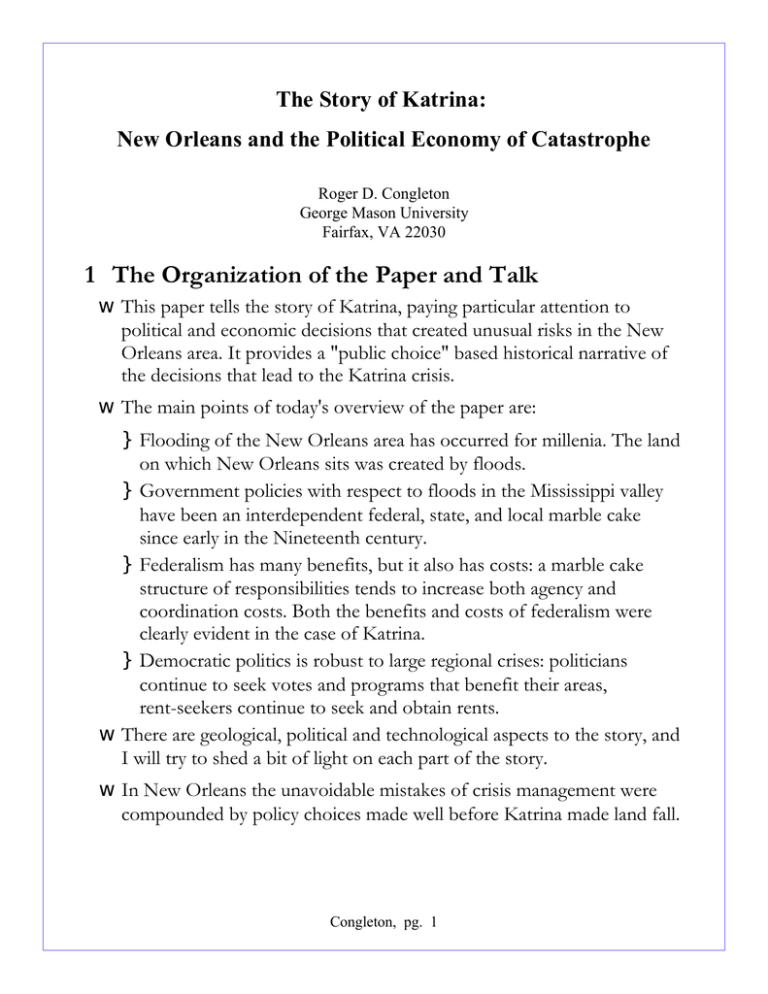
The Story of Katrina: New Orleans and the Political Economy of Catastrophe Roger D. Congleton George Mason University Fairfax, VA 22030 1 The Organization of the Paper and Talk w This paper tells the story of Katrina, paying particular attention to political and economic decisions that created unusual risks in the New Orleans area. It provides a "public choice" based historical narrative of the decisions that lead to the Katrina crisis. w The main points of today's overview of the paper are: } Flooding of the New Orleans area has occurred for millenia. The land on which New Orleans sits was created by floods. } Government policies with respect to floods in the Mississippi valley have been an interdependent federal, state, and local marble cake since early in the Nineteenth century. } Federalism has many benefits, but it also has costs: a marble cake structure of responsibilities tends to increase both agency and coordination costs. Both the benefits and costs of federalism were clearly evident in the case of Katrina. } Democratic politics is robust to large regional crises: politicians continue to seek votes and programs that benefit their areas, rent-seekers continue to seek and obtain rents. w There are geological, political and technological aspects to the story, and I will try to shed a bit of light on each part of the story. w In New Orleans the unavoidable mistakes of crisis management were compounded by policy choices made well before Katrina made land fall. Congleton, pg. 1 2 Setting the stage: the risk of flood is not new w About fifteen thousand years ago, an enormous sheet of ice across North America began to melt. } At that time the sea level was approximately 400 feet lower than it is today, because so much of Earth's water was in the form of ice. } As the ice melted, the oceans rose, and new land was created at the ends of rivers, as sediments carried by the glacial runoff were dropped at the places where the water slowed as it met the sea. } Variation in weather upstream produced repeated flooding downstream, which left low, wide, and deep deltas at the river ends and fertile flood plains along much of their lengths. } Although the coastline of the Gulf and elsewhere generally retreated as sea level rose, Louisiana's coastline gradually expanded—at least for a time—and the brackish Lake Pontchartrain formed as part of the gulf was surrounded by the expanding delta some three thousand years ago. } Without repeated flooding over a very long time, Louisiana would be a much smaller state, and there would be no Lake Pontchartrain and no New Orleans. w Life was, consequently, never simple in New Orleans. w The site of the original New Orleans’ trading post was initially higher than the Mississippi and protected from minor floods by its river banks which formed a natural levee; however, flooding was a problem from its earliest days. } The first recorded flood of the city occurred shortly after its founding, and floods continued to be perennial problems for its early residents. } Between 1735 and 1871 there are 38 recorded floods of New Orleans from river, rainfall, and Lake Pontchartrain. } Nine inundated New Orleans (Reeves 2005). w Consequently, houses were often built above ground on piers, and manmade levees were added to the ones that nature provided. Congleton, pg. 2 3 Economic origins of New Orleans w Human settlers arrived in the area around New Orleans well before the geological process had established the contours of southern Louisiana. } Substantial communities based on farming and fishing were established in the Mississippi’s lowlands about 2,500 years ago. } About two millennia later, in the sixteenth and seventeenth centuries, Spanish and French explorers passed through the Gulf coast region, and, as Europeans were prone to do at that time, they claimed the “new-found” lands for their respective empires. w A French colony at Biloxi, Mississippi, was founded shortly thereafter in 1699 (it was part of Louisiana at the time) and European settlement of contemporary Louisiana began. w In 1718 New Orleans was founded by French and Scottish entrepreneurs. } The location chosen for their new trading post was a relatively high and dry spot where Indians transported their canoes between the Mississippi River and Lake Pontchartrain. } It was a convenient place to trade with the long-established natives for crops, fish, and furs. w Colonial rule of New Orleans subsequently shifted from France to Spain and back again owing to European wars and politics, and finally to the United States in 1803 as Jefferson consummated his great land purchase from Napoleon. } Much of the new territory acquired was undeveloped and little used, but the part most densely inhabited under French rule became the state of Louisiana a few years later in 1812. w As Americans moved into the Ohio Valley and the Louisiana territory in the nineteenth century, commerce along the Mississippi River expanded and New Orleans became a small city. } River commerce also accelerated when new steam boats came into service, allowing goods to move upriver nearly as easily as down. w The low-lying trading post at New Orleans became a major port city. Congleton, pg. 3 4 Federalism and flood control is not new w Welfare economics implies that such local intergovernmental externalities create a role for more encompassing levels of government. } Following a major flood in 1844, the U.S. Congress passed the Swamp Act in 1849, which provided land grants to individual levee districts, the proceeds of which were to be used to fund construction of bigger and better levees along the Mississippi river by local levee authorities. } Major floods continued, however, with notable ones in 1850, 1858, 1862, 1865, and 1874. w In 1879, after this history of “local” flood disasters, the U.S. Congress created a new agency with authority over the entire river system, the Mississippi River Commission. } Under its authority, the Army Corps of Engineers took charge of flood control and transport within the entire basin (Penland 2005). } Shipping channels were dredged and new levees built. In 1927 another great flood trumped a half century of engineering efforts by the Corps of Engineers, killing 500 people. } This led still bigger and better levees to be designed and built. This time, however, the new levees were combined with modest efforts to restore some flood plains, and spillways were constructed to divert waters into other river channels in southern Louisiana. w Such measures reduce rather than increase flood pressures downstream, although “good” farmland finds itself occasionally under water. } Some risk of flooding on the river system always remains, but river flooding in Louisiana declined after 1927, in large part because of these more sophisticated efforts at water-level management. } Unfortunately, better management of Mississippi water levels did not entirely end the creation of new risks through public policy mistakes and coordination problems. Congleton, pg. 4 5 The Risk from Lake Pontchartrain Is Not New w The original New Orleans trading post was sited at the point of portage between the Mississippi River and Lake Pontchartrain. } The old settlement was above the river, the river is above sea level, and Lake Pontchartrain is essentially at sea level. } The city initially grew along a strip of high ground along a bend in the Mississippi River (hence its nickname of “Crescent City”) and subsequently downward from the river toward Lake Pontchartrain filling in the gap. w Levees were built to protect these new parts of the city from river floods and to drain and protect land from swamp and lake. } An unfortunate secondary effect of the success of the various levee projects was that as the protected areas dried out, they continued to settle, which gradually caused most of New Orleans to fall below sea level. } Lake Pontchartrain remained more or less at sea level, however, and so became a new flood risk for New Orleans. } Although lakes do not move as rivers do, their water levels are affected by inland storms, and in the case of Lake Pontchartrain also by storms in the Gulf of Mexico. w New Orleans has been flooded by Lake Pontchartrain several times, and, as the case with the River floods, successive lake floods led to successively bigger and better levees. } In 1871 the Mississippi River poured though a crack in the river levee at Bonnet Carre into Lake Pontchartrain; where aided by north winds and a weak lake levee it caused major flooding of New Orleans and many deaths. } In 1947 a storm surge associated with an unnamed hurricane flooded Jefferson Parish to depths of about three feet causing about 100 million dollars in damages. } This led to the construction of new taller and stronger “hurricane levees” along Lake Pontchartrain. Congleton, pg. 5 6 The Risk from Hurricanes is Not New w Together the natural, economic, and political history of New Orleans created a setting where catastrophe was not only possible but likely. w Past efforts at flood control have made storm-induced flooding far less frequent than it used to be, but also implies that floods will be more catastrophic when they occur. } The city is lower, and the new levees are higher. } Together, these imply that threatening storm waters are necessarily deeper and potentially far more deadly. w The current levee system was designed to resist a category 3 hurricane. } However, As evident from table 1 above, hurricanes stronger than category 3 pass through Louisiana every generation or so. Table 1 Number of Hurricanes Making Landfall in the U. S., By State and Wind Strength Category, 1851 - 2004 State Cat 1 Cat 2 Cat 3 Cat 4 Cat 5 Florida 43 32 27 6 2 Texas 23 17 12 7 0 North Carolina 21 13 11 1 0 South Carolina 19 6 4 2 0 Louisiana 17 14 13 4 1 Georgia 12 5 2 1 0 Alabama 11 5 6 0 0 Virginia 9 2 1 0 0 Mississippi 2 5 7 0 1 Source: NOAA Technical Memorandum, 2005, NWS TPC-4, “The Deadliest, Costliest, and Most Intense United States Hurricanes from 1851-2004” w Congleton, pg. 6 7 Risk Management in New Orleans 7.1 Federalism and free riding among levels of government w As noted above, levee externalities induced the national government to assume principal responsibility for flood control in the Mississippi basin more than a century ago. w Emergency responses after flood control failures are also jointly produced by all three levels of government—as well as by private organizations and individuals. } Police, fire, rescue, and emergency medical services have long been provided by local governments, as well as by volunteer groups and private individuals (who are often neglected in newspaper accounts of Katrina). } These “first responders” are backed up in extraordinary cases by a state’s national guard, which for intrastate purposes are controlled by the state governor. w The national government’s responsibility after a flood or other disaster is mainly that of a (taxpayer-subsidized) insurance company, and has been since the Great Depression. } In 1934 the Reconstruction Finance Corporation began providing subsidized loans for repair of public facilities after disasters. } In 1968 the Congress established the National Flood Insurance Program. } In 1979, the Federal Emergency Management Agency (FEMA) was created to centralize authority over the various national disaster relief programs authorized by Congress. w Fiscal responsibilities in these policy areas are also intertwined. } Funds for flood control projects flow from national to state and local providers and from state programs to local programs. } Intergovernmental grants supplement funds provided directly by the taxpayers of state and local governments. } Congleton, pg. 7 w Free-rider problems associated with diffuse responsibilities can account for lack of funding for the subsequent "Pam" planning session, and thereby for the poor evacuation planning by the city and state governments, the traffic problems along exit routes and the dearth of low cost–temporary housing in public facilities along those routes. 7.2 Free riding among successive mayors w Within the New Orleans area, where the risks from a major hurricane are direct and among the greatest in the country, because so much of its dense population lives below sea level, one might have anticipated more substantial planning than elsewhere in the state, whether assisted by the national and state governments or not. } After all, the residents of New Orleans were personally at risk! But little planning and preparation were evident. } No flood-proof New Orleans command center on high ground was established, no secure communication systems were purchased, and no operational plans for evacuating those without vehicles or requiring intensive medical care were adopted. w There is a possible rational choice explanation for this policy lacuna: mayors in New Orleans are limited to two four-year terms of office. } Although term limits address other significant problems, they imply that even a forward-looking mayor would not expect to be confronted personally with a “Pam-like” disaster. } The current levee system implies that serious storm threats to New Orleans occur only once a generation, rather than every few years as in the past. } Consequently, allocating city resources to address such catastrophes, would tend to benefit future governments, who would look well prepared, rather than current city officials, who would have fewer resources available for other shorter term projects. w The current mayor of New Orleans, an experienced manager from private industry (Nagin), had been in office for about three years when Katrina struck. Congleton, pg. 8 7.3 The Super Dome Plan w The official plan of the City of New Orleans was for its residents and visitors to pack up and evacuate the city. } This simple and relatively inexpensive emergency plan is not as silly as many newspaper, state, and national accounts make it sound. } After all, it is individuals and families that have the most at risk and have the best knowledge of their own particular circumstances and opportunities. } It is clear that the “Superdome plan” assumed, at least implicitly, that the levees would hold and that wind damage would be fairly modest, in spite of the fact that Katrina was a category 5 hurricane on Sunday morning (August 28) that would swamp the city if it reached the city at that strength. w It was known (or at least predicted) that about 100,000 persons would choose to remain in the city, even if “ordered” to leave, yet the preparations at the Superdome were only sufficient for about a fifth of the group that was likely to stay behind. w A vast supermajority of New Orleans citizens (more than 80 percent) heard the advice offered by national, state, and local officials—which was widely disseminated by newspapers, television interviews, and weathermen—and evacuated the city as Katrina approached. w However, among those that stayed in town were many persons who were not in a position to take independent action or to make rational risk-cost calculations, because they were incapable of leaving the city without considerable support or lacked relevant information—as is often true of elderly persons and others with physical or mental handicaps. w Deaths in New Orleans were disproportionately from this group. Congleton, pg. 9 8 Katrina makes landfall on August 29, 2005 w At 5:00 a.m. Monday morning, August 29, 2005, hurricane Katrina touched a thin peninsula of the Louisiana Bayou where the Mississippi River enters the Gulf of Mexico as a category 4 hurricane. w Six hours later it left the bayou and entered the continental mainland at the border of Louisiana and Mississippi as a category 3 hurricane. w The eye of the hurricane crossed Mississippi with gradually diminishing winds, falling to the level of a major tropical storm at 11:00 p.m. in Columbus, Mississippi and to an “ordinary” major storm in Tennessee, just west of Nashville. w Along the coast, a 10-20 foot-tall storm surge erased small towns and cities along the Mississippi coast, and uprooted and damaged oil platforms, harbors, and bridges. w A storm surge entered Lake Pontchartrain through its channel to the Gulf, overcame floodwalls that protected New Orleans from the lake, and flooded 80 percent of downtown New Orleans. w High winds and torrential rains damaged buildings and left more than two million people in Louisiana, Mississippi, and Alabama without electricity and more than a half million without homes. w Together, the failure of the dikes, the storm surge, wind, and rain led to more than 1,200 deaths. w Although not the most powerful hurricane to strike the United States in recent history, Katrina was by far the most deadly in the past half century. Congleton, pg. 10 9 Crisis management and mistakes in a federal system w Every crisis combines surprise and urgency. At the same time that the dislocated residents of New Orleans were busy solving resupply problems themselves, national, state, local, and private groups were attempting to deal with contingencies beyond those which they had planned for. } In such circumstances knowledge problems abound and, thus, error and mistakes are unavoidable (Congleton 2005). } The policy adjustments made by all levels of governments in the next few days certainly affirmed that prediction. w Three major dike failures, several minor ones, and inoperable pumping stations caused the earthen bowl that contained most of New Orleans to rapidly fill with water during the 24 hours after huriacane Katrina left town on Monday morning. 9.1 Urgency and ignorance lead to errors w Emergency supplies from FEMA and the Red Cross failed to reach persons in need for several days, failed to move at all, or were lost at supply depots. } In other cases, emergency supplies provided by private disaster relief groups and altruistic entrepreneurs were turned away by state officials—who evidently sought to control the distribution of supplies and services that never arrived. } Supplies and medical services were reportedly blocked from delivery into New Orleans by state officials (who evidently feared that the folks receiving them would not leave the city) at the same time that local police were preventing able-bodied folks from leaving the city on foot. } Calls from New Orleans to state officials for more help produced no new help, while the state and national personnel already present at the Superdome fled (via helicopter) in the face of angry mobs denied of “promised” emergency support. Congleton, pg. 11 } Emergency food supplies sent by allies abroad remained trapped at major airports, because of disorganization and restrictions on food from countries tainted by mad cow disease. w Of course, nearly every government official could claim with some justification that “someone else” had the responsibility for delivering the “promised” support. } Officially, the duty of providing post-emergency support was divided among local, state, and national governments—and even the Red Cross, which was designated as the national government’s “first responder” for food and shelter by the Department of Homeland Security. w Communication among government officials was very limited because of widespread damage to private telephone, cable, and radio networks. } Transport of those supplies that were available was slow, partly because of resultant coordination problems, but also because many roads and harbors were impassible. 9.2 Decentralized and spontaneous aide efforts w Although Katrina demonstrates how much can go wrong as a consequence of poor planning and error, it also demonstrates that a good deal of disaster relief can be produced without central coordination. } Local volunteers and local governments established relief centers at churches, schools, and community centers; others were established in private homes and motels throughout the affected states, in neighboring state, and across the United States as a whole. } Both in-kind and cash contributions poured into the region from private firms, NGOs, private persons, and foreign governments. Congleton, pg. 12 10 Politics as usual during and after the flood w News coverage during and after the levee failures in New Orleans clearly demonstrated that ordinary democratic politics continues to operate during and after major catastrophes. } Graphic television and newspaper accounts showed undeniable public policy failures, and fear of electoral retribution for those failures was evident from the first day of the New Orleans catastrophe. w From the very first press conferences in Louisiana and Washington D. C., virtually every government official with responsibility for planning for emergencies or providing emergency services pointed to the failures of others. } The Mayor of New Orleans wondered where the state national guard and FEMA were. } State officials noted the city’s lack of local preparation and FEMA’s failure to deliver promised supplies. } FEMA officials described the state and local governments as “disfunctional,” failing to take FEMA’s advice. } The national government “offered” to step in and take control of the Louisiana National Guard, which of course was simply another way of suggesting that the Louisiana State Government was totally incompetent. (Governor Blanco refused this particular offer of “help,” but no others that I am aware of.) w Officials at every level initially denied that anyone could have predicted a catastrophe like Katrina, despite the fact that professionals from all levels of government had participated in a planning exercise for just such a catastrophe only a year earlier! } Officials proclaimed that storms like Katrina had never happened before, despite the fact that Louisiana faces hurricanes every few years, major hurricanes every twenty years or so, and that equally powerful storms had threatened the same region just the year before! Congleton, pg. 13 w Lobbying to induce the national government to send large amounts of aid to New Orleans (and to Mississippi and Alabama) also began on the same day that the levees failed. w Within a month, seven emergency relief bills were passed by both chambers of the Congress and signed by the President. } Table 2 shows, however, that not all of the emergency appropriations are aimed at persons damaged by the hurricane, nor are they entirely directed to the states in which the damages occurred. Table 2 Hurricane Katrina Disaster Relief Funding ($ in billions) First Supp. Second Supp. Total FEMA 10.7 50 60.7 Manufactured Housing 3.3 1.6 4.9 Supplies/Materials 0.4 1.9 2.3 Temporary Financial Assistance 0.8 23.2 24 FEMA logistics 0.5 2.6 3.1 Infrastructure Repair 0.1 7.7 7.8 Damage Inspections 0.1 0.3 0.4 Urban Search/Rescue 0.1 0.1 0.2 Army Corps of Engineers 2.4 3 5.4 Department of Defense 2.1 2.5 4.6 Other 1 7.2 8.2 0.4 0.4 0.5 1.4 1.9 11.3 51.9 63.2 Army Corps of Engineers Department of Defense Total Source: Budget Bulletin, Senate Budget Committee, September 12, 2005. (The totals include small rounding errors.) Congleton, pg. 14 11 Public Choice Lessons from Katrina w By providing unusual stresses on political institutions, crises often reveal political behavior more clearly than ordinary times. } Katrina, thus, provides very useful information about existing political institutions and also powerful tests of existing theories of public policy formation. } Although more error prone than in less urgent times, “politics as usual” was clearly in evidence. } Politicians continued to respond to reelection pressures. Interest groups continued to lobby and receive rents. } Coordination among levels of government remained problematic in areas of overlapping responsibilities, whatever might have been claimed beforehand.1 w Many of the institutional lessons of Katrina also follow from mainstream public choice analysis. } Katrina affirms that competition within Federal systems exists, but suggests that it is less rigorous than postulated in Tiebout models. } Both above- and below-average governments evidently coexist at both state and local levels of government. } Consequently, miscalculations will be larger in some states than others for reasons only indirectly connected to federalism. } In the case of Louisiana, a more complex and difficult public policy problem had to be addressed by below-average state and local governments, and the result was less than might be hoped for.2 } On the other hand, above-average state governments deal with similar storms with fewer failures and far lower damages. Florida, for example, responds to similar emergencies with far greater success within more or less similar institutions. Indeed, help from Florida was among the first to arrive in the Gulf region after Katrina departed. } } } Congleton, pg. 15 w Federalism’s strengths and weaknesses were also in evidence. } On the one hand, national risk pooling allowed resources gathered at the national level to be directed to regional catastrophes, increasing support levels for those affected by natural disaster. } On the other, numerous coordination problems arose because responsibilities are shared among several levels of government. } Dikes were not as well maintained as they should have been because responsibilities for funding and undertaking it were divided among several government agencies and several levels of government. } Public policies before, during, and after a crisis were affected by free riding and dis-coordination, at the same time that yardstick competition, efficiency, and innovation are encouraged. } The greater effectiveness of Florida’s hurricane policies allows voters (and researchers) to determine that the failures of Louisiana and Mississippi are not simply bad luck. } (Note that many other cities in the Southeastern United States were also affected by hurricanes in 2005, although they faced substantially smaller risks because they are not below sea level.) w Rational choice-based political research has also long stressed that long-term inter-generational externalities are difficult for democracies to solve. } Both politicians and rent-seeking firms tend to focus on policies that most directly affect their next reckoning with the polls and accountants. } Voters and consumers tend to care more (rather than less) about the future consequences of public policies than persons operating in environments in which short-term results are used as measures of productivity that determine personal wealth, power, and prestige. } However, voters do not have the information, time, or imagination to analyze every long-term policy problem that exists, nor to easily monitor how well their agents advance that subset of their long term goals addressed through public policy. Congleton, pg. 16 w Many policy problems can, thus, fall between the cracks of modern political systems. } Katrina, clearly demonstrated the existence of such fault lines. Levees were underbuilt, emergency plans were poorly worked out, and provisions for once-a-generation natural disasters were not in evidence. } In this case, the institutional failures were graphically revealed by physical cracks in levees and by the breakdown of law and order. } In other cases, the gaps in long-term policies may be less concrete, but they may also produce results that are far from optimal. w Katrina demonstrates that such hidden institutional fault lines are clearly worthy of analysis, because institutional weaknesses can and do produce catastrophes when placed under unusual stress. w w w For more on Katrina see: http://rdc1.net/forthcoming/KATRINA3.pdf Congleton, pg. 17 Congleton, pg. 18 1 Examples of pre-Katrina assurances can be taken from many official sources. Consider this passage from a speech of Homeland Security Secretary Ridge to the American Red Cross on May 21, 2004. “So this Department is determined to forge operational capacity when it comes to emergency preparedness. Our goal is to ensure that when and if disaster strikes—our governors, mayors, police, firefighters, hospital staff, Red Cross volunteers—all have the tools and resources they need to respond. I am pleased to say that we are already making great progress in this area. At Homeland Security we have worked to provide a framework for emergency preparedness planning that will guide and coordinate the integration of our national response capabilities.” 2 The Statistical Abstract of the United States reports that Mississippi and Louisiana are the first and seventh lowest in per capita incomes, and their citizens are the second and eighth least likely to have graduated from college. Mississippi and Lousiana are the first and third most corrupt states (Corporate Crime Reporter, January 2004). Prior to Katrina’s landfall, the U.S. Attorney’s office had indicted 16 officials in Louisiana for misuse of FEMA funds, including 3 of Louisiana’s top emergency officials (Scripps Howard News Service, 5-02-05). The U.S. Bureau of the Census (Historical Population Counts, 1900 to 1990) reports that the city of New Orleans (Orleans Parish) has been continually losing population since 1960, when its population was 627,525. By 2000, its population had fallen to 462,269. The population of the metropolitan area as a whole, however, has increased, from 1.26 in 1990 to 1.31 million in 2000.


